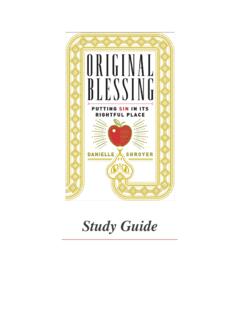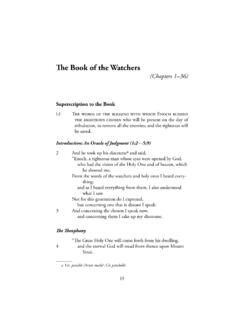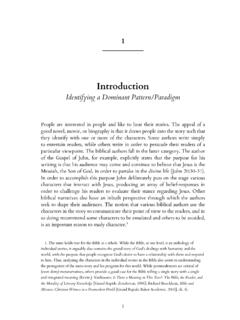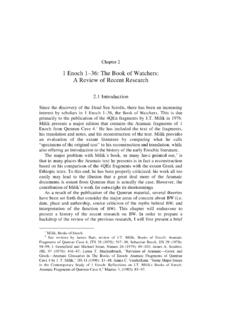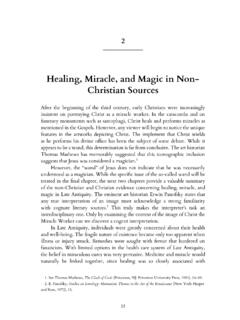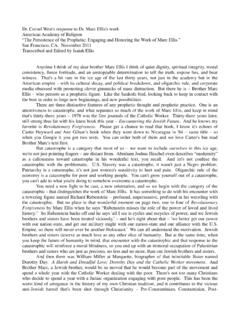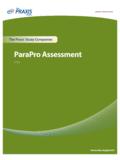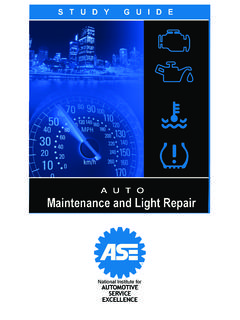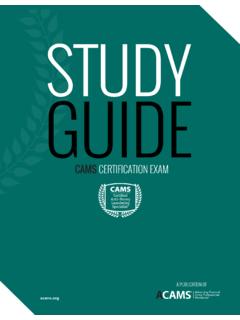Transcription of Study Guide for Introduction to the Hebrew Bible and A ...
1 Study Guide for Introduction to the Hebrew Bible and A Short Introduction to the Hebrew Bible by John J. Collins 2014 Minneapolis: Fortress Press Note: Since most commentary titles are simply the title of the biblical book, the form for most commentaries in a series is as follows: author, series, and date. I have spelled out the titles of commentaries that are not in a series. Commentaries that cover multiple biblical books ( , Marvin A. Sweeney, The Twelve Prophets, BerO, 2000) are listed under each book they treat. Abbreviations AB Anchor Bible ABD Anchor Bible Dictionary. Edited by D. N. Freedman. 6 vols. New York: Doubleday, 1992 AnBib Analecta biblica ANET Ancient Near Eastern Texts Relating to the Old Testament. Edited by J. B. Pritchard. 3rd ed. Princeton: Princeton Univ. Press, 1969 AOTC Abingdon Old Testament Commentaries BA Biblical Archaeologist BAR Biblical Archaeology Review BETL Bibliotheca ephemeridum theologicarum lovaniensium Bib Int Biblical Interpretation BZAW Beihefte zur Zeitschrift fur die alttestamentliche Wissenschaft CBQMS Catholic Biblical Quarterly Monograph Series CC Continental Commentaries CEJL Commentaries on Early Jewish Literature CHANE Culture and History of the Ancient Near East ConBOT Coniectanea biblica (Old Testament series)
2 FOTL Forms of the Old Testament Literature GBS Guides to Biblical Scholarship HSM Harvard Semitic Monographs HTR Harvard Theological Review ICC International Critical Commentary ITC International Theological Commentary JBL Journal of Biblical Literature JPS Jewish Publication Society JSJSup Journal for the Study of Judaism Supplement Series JSOT Journal for the Study of the Old Testament JSOTSup Journal for the Study of the Old Testament Supplement Series LXX Septuagint (Greek version) MT Masoretic text NCB New Century Bible NIB New Interpreter s Bible NICOT New International Commentary on the Old Testament NRSV New Revised Standard Version OBT Overtures to Biblical Theology OEANE Oxford Encyclopedia of Archaeology in the Near East. Edited by E. M. Meyers. 5 vols. New York: Oxford University Press, 1997 OTL Old Testament Library SBL Society of Biblical Literature SBLDS SBL Dissertation Series SBLEJL SBL Early Jewish Literature Series SBLMS SBL Monograph Series SBLWAW SBL Writings from the Ancient World VTE Vassal Treaties of Esarhaddon VTSup Supplements to Vetus Testamentum WBC Word Biblical Commentary WMANT Wisssenschaftliche Monographien zum Alten und Neuen Testament Introduction Questions for Review and Discussion 1.
3 How does the Protestant Old Testament differ from the Hebrew Bible ? 2. How does the Catholic Old Testament differ from the Protestant canon? 3. What are Apocrypha, Pseudepigrapha, Deuterocanonical books, and the Septuagint (LXX)? 4. What are the oldest manuscripts of the Hebrew Bible ? 5. Why is the Greek translation important for the text of the Hebrew Bible ? 6. What new light has been shed on the formation of the Hebrew Bible by the Dead Sea Scrolls? 7. According to the Bible s own chronology, when did the Exodus take place? 8. Why is the Bible s own chronology regarded as problematic? 9. According to modern scholars, when was the Torah or Pentateuch completed? 10. When did the canon of the Hebrew Bible take shape? 11. What is form criticism? Redaction criticism? One-Volume Commentaries Barton, John, and John Muddiman, editors. The Oxford Bible Commentary. Oxford: Oxford Univ.
4 Press, 2001. Brown, Raymond E., Joseph A. Fitzmyer, and Roland E. Murphy, editors. The New Jerome Biblical Commentary. Englewood Cliffs, : Prentice-Hall, 1990. Dunn, James D. G., and John Rogerson, editors. Eerdmans Commentary on the Bible . Grand Rapids: Eerdmans, 2003. Farmer, William R., The International Bible Commentary: A Catholic and Ecumenical Commentary for the Twenty-First Century Collegeville, Minn.: Liturgical, 1998. Mays, James L., editor. The HarperCollins Bible Commentary. Rev. ed. San Francisco: HarperSanFrancisco, 2000. Newsom, Carol A., and Sharon H. Ringe, editors. Women s Bible Commentary. Expanded edition. Louisville: Westminster John Knox, 1998. Online Resources iTanakh (R. Christopher Heard) an index of internet resources for the Study of the Hebrew Bible Old Testament Gateway an annotated academic directory to websites on the Old Testament Chapter 1.
5 The Near Eastern Context Questions for Review and Discussion 1. Who were the Sumerians? 2. What is Akkadian? Ugaritic? 3. For what was Hammurabi famous? When did he live? 4. When were the Egyptian pyramids built? 5. What are the Amarna letters? 6. Who was Akhenaten? When did he live? 7. Identify: Atrahasis, Tiamat, Enkidu, Utnapishtim. 8. How does the myth Enuma Elish relate to the political order in the ancient Near East? 9. What are the main episodes in the cycle of myths relating to the Canaanite god Baal? How might they be explained? 10. In what ways did Egyptian accounts of creation differ from those of Mesopotamia? Online Resources ETANA Guide to resources on the ancient Near East Ancient Near Eastern Maps (Oriental Institute) The Old Testament and the Ancient Near East (Ralph W. Klein) ~rklein/ Websites Relating to the Ancient Near Eastern World ( Hanson) Chapter 2.
6 The Nature of the Pentateuchal Narrative Questions for Review and Discussion 1. Why do scholars distinguish different sources in the Pentateuch? 2. What are the major identifying characteristics of the J source? Of the E source 3. What is the profile of the P source? Of D? 4. What is the importance of the reform of King Josiah in 621 for dating the sources of the Pentateuch? 5. What are some current criticisms of the documentary hypothesis? Chapter 3. The Primeval History Questions for Review and Discussion 1. What are the main similarities and differences between the Atrahasis myth and Genesis 1 11? 2. In what ways does the story of Gilgamesh shed light on the story of Adam and Eve? 3. How should we understand the role of the serpent in the story of Adam and Eve? 4. Does the story of Adam and Eve imply a doctrine of original sin? Does it imply that women should be subordinate to men?
7 5. In what ways does the flood story in Genesis differ from other flood stories of the ancient Near East? 6. What are the main differences between the Priestly account of creation in Genesis 1 and the Yahwist (J) account in Genesis 2 3? 7. What are the main themes that run through the primeval history (Genesis 1 11) in the Yahwist source? Commentaries Alter, Robert. Genesis: Translation and Commentary. 1996. Brueggemann, Walter. NIB 1. 1994. Cotter, David W. BerO. 2003. Fox, Everett. SB 1. 1995. Hamilton, Victor P. 2 vols. NICOT. 1990, 1995. Janzen, J. Gerald. ITC. 1993. Sarna, Nahum M. JPSTC. 1989. Wenham, Gordon G. 2 vols. WBC 1, 2. 1987, 1994 Westermann, Claus. CC. 1984. Chapter 4. The Patriarchs Questions for Review and Discussion 1. What dates are implied for Abraham, Isaac, and Jacob by the Bible s internal chronology? Why are these dates problematic?
8 2. What was the contribution of Hermann Gunkel to the understanding of the patriarchal stories? 3. How does the religion of the patriarchs differ from the religion of Israel as it is described in later books such as Deuteronomy? 4. Discuss the role of deception in the stories of Abraham and Jacob. How would you address the ethical problems presented by these stories? 5. How would you address the ethical problem presented by the sacrifice of Isaac in Genesis 22? 6. What purposes are served by the story of Judah and Tamar in Genesis 38? 7. What are the main themes in the Joseph story? What function does this story fill in the unfolding story of Israel? Commentaries Alter, Robert. Genesis: Translation and Commentary. 1996. Brueggemann, Walter. NIB 1. 1994. Cotter, David W. BerO. 2003. Fox, Everett. SB 1. 1995. Hamilton, Victor P. 2 vols. NICOT. 1990, 1995. Janzen, J. Gerald.
9 ITC. 1993. Sarna, Nahum M. JPSTC. 1989. Wenham, Gordon G. 2 vols. WBC 1, 2. 1987, 1994 Westermann, Claus. 2 vols. CC. 1985, 5. The Exodus from Egypt Questions for Review and Discussion 1. What evidence is there for an exodus of Hebrews out of Egypt in the latter part of the second millennium 2. Who were the Hyksos? 3. How does archaeological evidence support the biblical story of the Exodus, or put it in question? 4. What is the genre of the narratives in Exodus 1 18? What are the problems in using them as historical sources? 5. What are the oldest traditions that relate the God YHWH to Mount Sinai? What can we learn from them about the early religion of Israel? 6. How do you understand the encounter between Moses and YHWH at the burning bush? 7. How do you understand the story of the crossing of the sea? Can the poem in Exodus 15 be used as an historical source? 8.
10 Why is God regarded as a warrior in Exodus? Commentaries Coats, George W. FOTL 2A. 1999. Durham, John I. WBC 3. 1987. Fox, Everett. SB 1. 1995. Fretheim, Terence E. IBC. 1991. Kaiser, Walter C., Jr. NIB 1. 1994. Meyers, New Cambridge Bible Commentary, 2005 Propp, William H. C. AB 2. 1999, 2006. Sarna, Nahum M. JPSTC. 1991. Chapter 6. The Revelation at Sinai Questions for Review and Discussion 1. Why are Hittite treaties important for understanding the Mosaic covenant? 2. How do you understand the development of monotheism in Israel? What evidence is there for the worship of the goddess Asherah? 3. What is the difference between apodictic and casuistic law? 4. What is the Book of the Covenant? When is it likely to have originated? 5. What is the attitude to slavery in the laws of Exodus? To adultery? 6. Is biblical law relevant to modern discussions of the death penalty?
